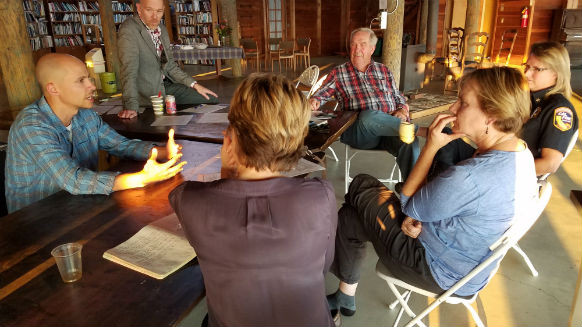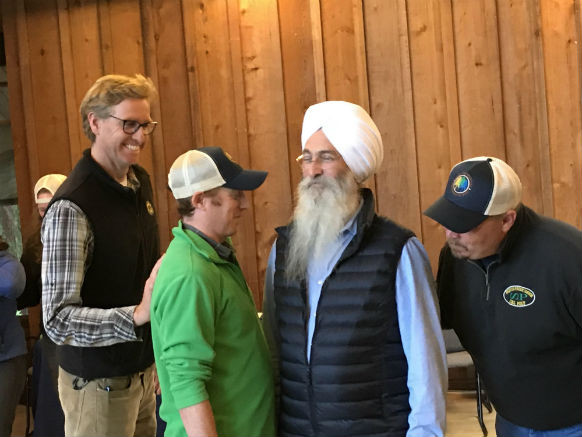 A small group at an SCMSN convening discusses regional stewardship collaboration. (Photo by Kellyx Nelson)
A small group at an SCMSN convening discusses regional stewardship collaboration. (Photo by Kellyx Nelson)
Social impact networks offer a foundation for collaborations driven by shared purpose. Most models for developing networks for collaboration emphasize discovering or clarifying purpose as the first step. But purpose doesn’t always have to manifest in the form of a single vision or strategic plan shared among all participants—indeed, narrower views of it can sometimes discourage collaboration. Purpose can be diffuse, multiple, and emergent, and still bring many kinds of stakeholders together.
I often describe the work of the Santa Cruz Mountains Stewardship Network (SCMSN), which I manage, as driven by “complex purpose.” While it has a high-level, shared purpose of helping California’s Santa Cruz Mountains region thrive, it doesn’t organize any specific action. Instead, its many action-level purposes arise from a process in which interaction between network members reveals clusters of shared interest. Different-but-overlapping constellations of members determine to work on each cluster. In this way, SCMSN pursues many kinds of projects together without a shared vision or strategic plan.
Organizing action
Learning to work this way takes time. The SCMSN is a land stewardship network comprised of 21 very different organizations, including land trusts, public agencies like state and county parks, a timber company, universities, and an indigenous tribal band. Beginning when the network formed, it was clear there were many areas of mutual interest even though members’ missions varied widely. And because the relationships were new, no one was sure what kinds of collaborations would be viable. We were clear about wanting the region to thrive but not about which actions we would engage to support it.
Discovering purpose at an action level involved conversation—sharing information on projects, and getting to know and trust each other. (Converge, a consultancy that helped the network form, started this process. I continued it when I came on as network manager.) At moments when several members identified a shared interest, I helped move the discovery forward by identifying and reflecting that shared interest back to the group, structuring agendas to explore the issue more completely, and encouraging members to consider whether their organization would commit to the issue. Together, we worked on an issue until either a team formed around it, or a lack of interest, time, or resources made it clear we should abandon it. I also asked members to develop specific goals they thought the network could help their organization achieve.
Are you enjoying this article? Read more like this, plus SSIR's full archive of content, when you subscribe.
Over the past three years, we have identified multiple shared interests, and formed project teams around things like invasive plant species, climate change modeling, and a land-stewardship education program for community leaders. Members have also pursued more than 65 collaborative land stewardship projects—all planned outside of the formal process we typically use to identify and build teams. The Amah Mutsun Land Trust, State Parks, and the San Mateo Resource Conservation District, for instance, are partnering to restore 1,800 acres of grasslands in the region. The Amah Mutsun Land Trust will use native stewardship practices to do the restoration on State Parks land, and the San Mateo Resource Conservation District will handle the permitting process. While this isn’t formally a network project, it would not have happened without the relationships members developed within the network.
As we have achieved project goals (creating workshops on streamlining the permitting process for restoration projects, for instance, or salon events for practitioners on topics like controlled burning to reduce the risk of wildfires), the network has developed a better sense of what it is and how it can serve the greater region—all without a strategic plan. Indeed, new projects arise not for lack of a plan, but because there isn’t one. Members organize projects together based on their needs and interests, and each of the projects relates back to the high-level purpose of helping the region thrive. Taken together, they create a tacit but unified sense of purpose for SCMSN, which drives us forward toward greater collaboration.
Network leaders weigh in
Curious about how our approach compared with other networks, I asked several network leaders to offer their perspective on complex purpose. While their terminology differs, I found that all of them explored purpose at multiple levels with the members of their networks.
Shawn Johnson, managing director of the Center for Natural Resources & Environmental Policy at the University of Montana, works with several networks, including the Network for Landscape Conservation and the California Landscape Stewardship Network. Johnson says that while he used to think about purpose in networks as a matter of framing a specific, shared vision, he now thinks complex networks that comprise a wide diversity of interests and actors must have multiple purposes. Similar to how SCMSN thinks in terms of high-level and action-level purpose, he says there is “motivational” purpose (what motivates people to work together) and “substantive” purpose (the substance of that collaborative work). It makes sense for there to be a range of substantive purposes, says Johnson. His view is that if we say no to that diversity, we say no to the new possibilities that are part of networks’ real value. And to harness the power and impact of networks, participants must be willing for things to happen at different scales and time horizons. While this may feel scattered to people who aren’t used to working this way, when aligned with the network’s shared motivational purpose, these actions can add up to significant activity and impact.
The idea of complex purpose also resonated with Faith Graham, managing director of the Network for Energy, Water, and Health in Affordable Buildings (NEWHAB). She describes networks as an organizing structure for collaboration that can produce many outcomes, not just one. She says that NEWHAB’s members are aligned on the visionary “what,” but that the purposeful “how” is in a constant state of co-creation. Over time, she says, members have increasingly understood that the network is a tool to help them accomplish multiple goals. So they can form a community of practice that addresses policy barriers in a particular region, for example, and experiment with techniques to engage residents in decision-making. These goals and others all contribute to NEWHAB’s vision of increasing equitable access to affordable, healthy, and sustainable housing for all.
When it comes to purpose, says Odin Zackman, a consultant who works with networks, including NEWHAB and the Water Solutions Network, there is a tension between wanting to nail down the network’s purpose and allowing its purpose to emerge. This tension plays out as a definitional challenge: What are we trying to do together? What is our practice? What is our structure for working together?
Sharon Farrell, vice president of stewardship and conservation at the Golden Gate National Parks Conservancy, coordinates the California Landscape Stewardship Network and One Tam, a network of several public agencies that steward Mount Tamalpais in Marin County. One Tam differs from SCMSN in that its action-level purpose is expressed through a single shared plan that guides the agencies’ stewardship work on Mount Tamalpais. And yet Farrell points out that the same complex dynamics and overlapping interests that define SCMSN are also at play within One Tam. The network didn’t start out with a shared plan; it had to go through a process of discovery to figure out how to work together.
Creating the conditions for collaboration
At this point in its evolution, One Tam’s action-level purpose is clear—the four public agencies that make up the network manage Mount Tam’s 25,000 acres for recreation and ecological health. But other networks that, like SCMSN, discover action-level purposes continuously over time may require that the network manager reflect activities back to members so as to make those purposes visible. I have also found it important to consistently point out how the network creates the conditions for collaborative stewardship by spending time together, building relationships, and sharing information. That is how projects emerge—not always right away, but over time.
These practices are useful, because the ambiguity of the collaborative process in a network means results aren’t always obvious. Early on at SCMSN, members would describe how helpful knowing who to call at other member organizations was and how important that was for achieving their work. But in the next breath, they would fret that we were not achieving anything as a network. Reminding members that accomplishment comes in many forms was important in building that tacit sense of purpose that keeps SCMSN feeling vital.
 Members engage in a trust exercise at an SCMSN convening. (Photo by Dylan Skybrook)
Members engage in a trust exercise at an SCMSN convening. (Photo by Dylan Skybrook)
Even when purposes are diffuse, multiple, and emergent, networks can cultivate collaboration using the following tactics:
-
Recognize diverse needs among network members. Facilitate conversations where network members can express their needs so that the entire group can understand that not everyone wants the same thing.
-
Cultivate clusters of mutual interest. Look for issues where at least a few members’ needs intersect, and then seek connections to the rest of the network. Facilitate exploratory conversations about the issues to see if they might become viable projects.
-
Cultivate a tolerance for ambiguity. Communicate to members the unique nature of a network: It is a group of peers looking to collaborate or share information, not a command-and-control structure.
-
Build trust between members. Facilitate situations in which people get to know each other more deeply than their professional relationships often allow. This can include getting to know more about each other’s lives, or engaging in activities that bring people out of their usual zones of engagement, such as field trips, happy hours, or exercises that have a physical component.
-
Encourage information-sharing. Sharing information is how people make the connections that lead to collaboration. This might look like going around the room and having each member give updates on relevant projects, or it might look like a shared database or repository of scientific papers and other resources.
-
Encourage self-organization. Facilitate conversations where the members generate ideas by talking to each other and discover how the network can do work that their individual organizations might not be able to. Project ideas that arise from this process have a chance of being relevant enough for member organizations to dedicate time and resources to achieving.
-
Mirror back the work. As I noted above, it is important to remind network members of the work the network is doing, the results it has achieved, and especially the ripple effects that may follow. Not every member works on every project, so some efforts and achievements may not be very visible. Regular reflection provides a fuller picture and sense of purpose.
A network’s complexity and the complexity of its purposes correlate. Having more members and interests can mean that a single shared purpose is more difficult to come by. Adopting an emergent, complex purpose approach to collaboration allows organizations to decide to work together even when creating a collective plan isn’t possible or appropriate. Indeed, even if a network does have a shared plan, the idea of complex purpose can still be a useful lens.
Support SSIR’s coverage of cross-sector solutions to global challenges.
Help us further the reach of innovative ideas. Donate today.
Read more stories by Dylan Skybrook.

